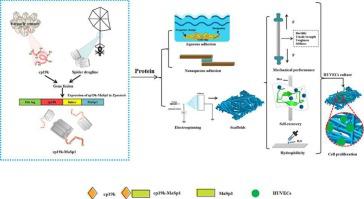International Journal of Biological Macromolecules ( IF 7.7 ) Pub Date : 2023-09-28 , DOI: 10.1016/j.ijbiomac.2023.127125 Luona Ye 1 , Xiaoxiao Liu 1 , Kai Li 1 , Xiaoyan Li 1 , Jiarui Zhu 1 , Shu Yang 1 , Li Xu 1 , Min Yang 1 , Yunjun Yan 1 , Jinyong Yan 1

|
Biomaterials with excellent biocompatibility, mechanical performance, and self-recovery properties are urgently needed for tissue regeneration. Inspired by barnacle cement and spider silk, we genetically designed and overexpressed a fused protein (cp19k-MaSp1) composed of Megabalanus rosa (cp19k) and Nephila clavata dragline silk protein (MaSp1) in Pichia pastoris. The recombinant cp19k-MaSp1 exhibited enhanced adhesion capability beyond those of the individual proteins in both aqueous and non-aqueous conditions. cp19k-MaSp1 protein fiber scaffolds prepared through electrospinning have adequate hydrophilicity compared to cp19k and MaSp1 protein fiber scaffolds, and offer improved overall porosity compared to MaSp1 protein fiber scaffolds. The cp19k-MaSp1 protein fiber scaffolds showed excellent proteolytically stable properties because of only 9.6 % depletion after incubation in a biodegradation solution for 56 d. The cp19k-MaSp1 protein fiber scaffolds present remarkably high extreme tensile strength (112.7 ± 11.6 MPa) and superior ductility (438.4 ± 43.9 %) compared with cp19k (34.4 ± 8.1 MPa, 115.4 ± 32.7 %) and MaSp1 protein fiber scaffolds (65.8 ± 9.3 MPa, 409.6 ± 23.1 %), also 68.4 % of tensile strength was recovered by incubation in K+ buffer after multiple stretches, which create a favorable cell adhesion, growth, and proliferation environment for human umbilical vein endothelial cells (HUVECs). The improved biocompatibility, extensive adhesion, mechanical strength, and self-recovery properties make the bioinspired synthetic cp19k-MaSp1 a potential candidate for biomedical tissue reconstruction.
中文翻译:

由藤壶水泥和蜘蛛拉铲制成的仿生合成融合蛋白粘合剂,用于潜在的生物医学材料
组织再生迫切需要具有优异生物相容性、机械性能和自我恢复性能的生物材料。受藤壶水泥和蜘蛛丝的启发,我们在毕赤酵母中基因设计并过表达了由梅花巨巴拉努斯(cp19k)和棒新妇拉丝蛋白(MaSp1)组成的融合蛋白(cp19k-MaSp1)。重组 cp19k-MaSp1 在水性和非水性条件下均表现出比单个蛋白质更强的粘附能力。通过静电纺丝制备的cp19k-MaSp1蛋白纤维支架与cp19k和MaSp1蛋白纤维支架相比具有足够的亲水性,并且与MaSp1蛋白纤维支架相比具有改善的整体孔隙率。cp19k-MaSp1 蛋白纤维支架表现出优异的蛋白水解稳定性,因为在生物降解溶液中孵育 56 天后仅消耗 9.6%。与 cp19k (34.4 ± 8.1 MPa, 115.4 ± 32.7 %) 和 MaSp1 蛋白纤维支架 (65.8 ± 43.9 %) 相比,cp19k-MaSp1 蛋白纤维支架具有极高的极限拉伸强度 (112.7 ± 11.6 MPa) 和优异的延展性 (438.4 ± 43.9 %)。 9.3 MPa, 409.6 ± 23.1%),多次拉伸后在K +缓冲液中孵育可恢复68.4%的拉伸强度,为人脐静脉内皮细胞(HUVEC)创造了良好的细胞粘附、生长和增殖环境。改进的生物相容性、广泛的粘附力、机械强度和自我恢复特性使仿生合成 cp19k-MaSp1 成为生物医学组织重建的潜在候选者。













































 京公网安备 11010802027423号
京公网安备 11010802027423号